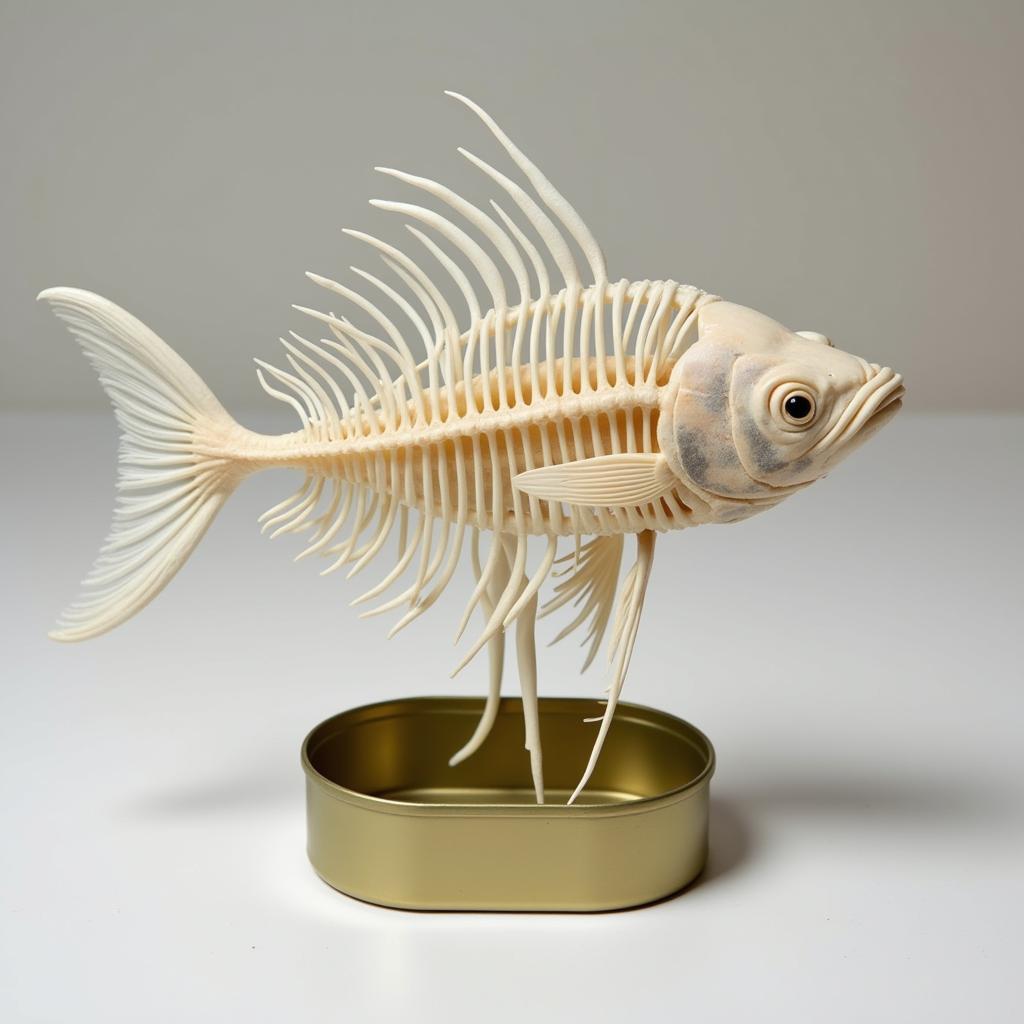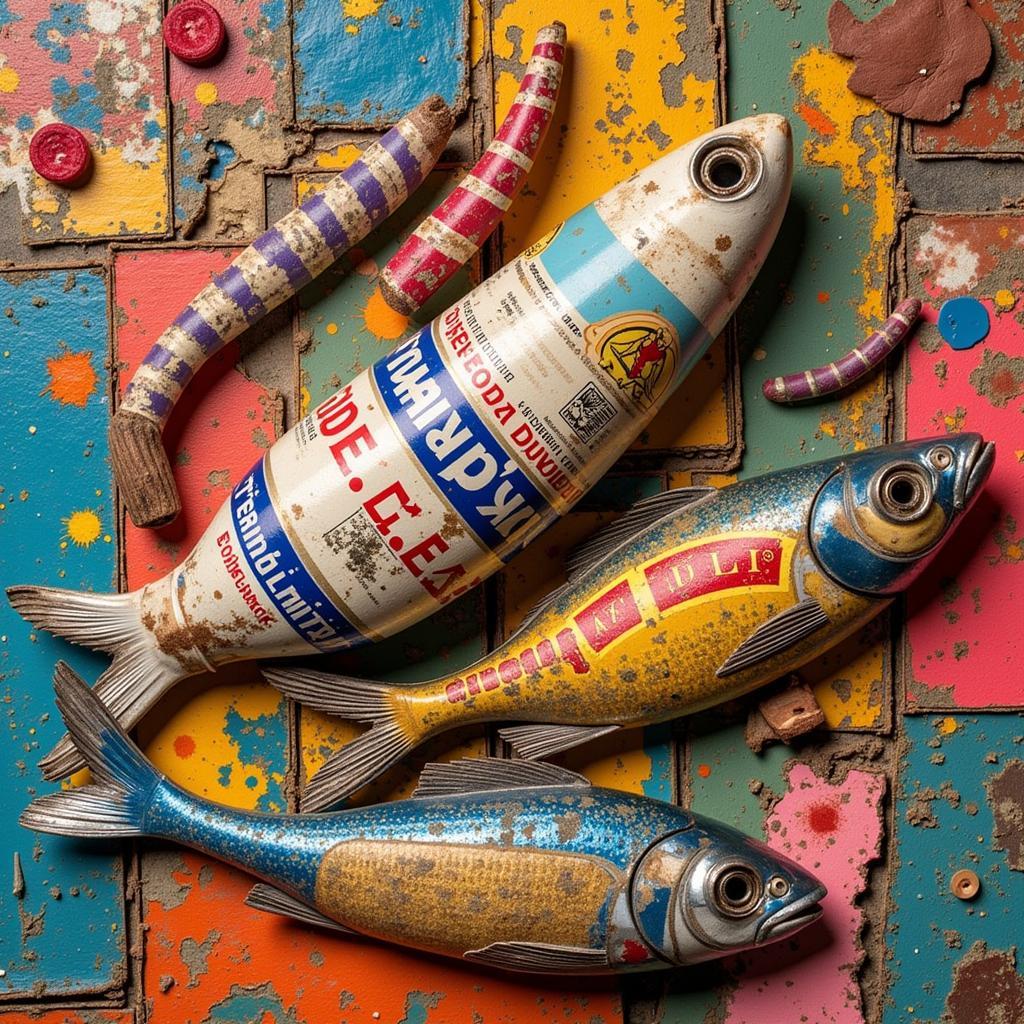Transforming Tinned Fish into Art: A Creative Exploration
Tinned Fish Art is an exciting and unexpected new trend that’s making waves in the art world. From sardines to tuna, artists are finding inspiration in the everyday and transforming humble tinned fish into stunning works of art. This unique medium offers endless possibilities for creativity, allowing artists to explore themes of consumerism, sustainability, and the beauty of the mundane.
Diving Deep into the World of Tinned Fish Art
Tinned fish art is more than just crafting with cans; it’s about reimagining the ordinary and finding beauty in unexpected places. Artists are utilizing the cans, the fish itself, and even the oil or brine to create textured, thought-provoking pieces. Some artists focus on the intricate details of the fish skeleton, creating delicate bone sculptures. Others incorporate the can’s label into their work, exploring themes of branding and mass production. The metallic sheen of the can itself can be incorporated, adding a unique reflective element to the artwork. Still others are using the fish itself, preserved in resin or other mediums, to create captivating and sometimes unsettling pieces.
What’s driving this fishy trend? Perhaps it’s the inherent irony of elevating something so commonplace to the realm of art. Perhaps it’s a commentary on our consumption habits. Or maybe it’s simply the unique aesthetic possibilities that tinned fish offers. Whatever the reason, tinned fish art is here to stay.
 Tinned Fish Art Sculpture: A sardine skeleton transformed into art
Tinned Fish Art Sculpture: A sardine skeleton transformed into art
Exploring Different Techniques in Tinned Fish Art
From intricate fishbone sculptures to mixed-media collages, the techniques used in tinned fish art are as diverse as the artists themselves. Some popular methods include:
- Fishbone Sculptures: This involves carefully cleaning and arranging the delicate bones of tinned fish to create intricate sculptures.
- Can Label Art: Artists incorporate the original can labels into their work, often juxtaposing them with other materials to create a collage effect.
- Mixed Media: Combining the tin can, fish, label, and other materials like resin, paint, and found objects opens up a world of creative possibilities.
- Printmaking: Using the tin can as a printing block allows artists to create unique patterns and textures.
 Tinned Fish Art Mixed Media Collage: A vibrant mix of materials
Tinned Fish Art Mixed Media Collage: A vibrant mix of materials
Is Tinned Fish Art Sustainable?
One of the appealing aspects of tinned fish art is its potential for sustainability. By repurposing discarded cans and fish bones, artists are giving new life to materials that would otherwise end up in landfills. This eco-conscious approach resonates with a growing awareness of environmental issues and adds another layer of meaning to the artwork. However, the use of resins and other non-biodegradable materials in some tinned fish art raises questions about its overall environmental impact. This is a conversation that the tinned fish art community is actively engaging with, exploring ways to minimize its ecological footprint.
How can I get started with Tinned Fish Art?
Starting with tinned fish art is surprisingly simple. All you need are some empty tin cans, a pair of tweezers, some glue, and your imagination. Experiment with different techniques, explore different types of fish, and don’t be afraid to get messy.
“Tinned fish art allows us to see the everyday in a new light,” says renowned mixed-media artist, Amelia Herring. “It’s about finding beauty in the discarded and transforming the mundane into something extraordinary.”
Tinned Fish Art: A Growing Movement
Tinned fish art has quickly gained traction, capturing the attention of art enthusiasts and environmentalists alike. Its accessibility and unique aesthetic have made it a popular choice for both established artists and aspiring creatives. As the movement continues to evolve, we can expect to see even more innovative and thought-provoking works emerge from this surprising medium.
In conclusion, tinned fish art offers a unique and engaging way to explore creativity, sustainability, and the beauty of the everyday. From intricate sculptures to powerful statements about consumerism, this emerging art form is making waves and inviting us to rethink our relationship with the ordinary. So, grab a can, unleash your imagination, and dive into the fascinating world of tinned fish art.
FAQ
- What is tinned fish art?
- Tinned fish art uses tinned fish, cans, and related materials to create art.
- Is it expensive to start?
- No, the materials are usually readily available and inexpensive.
- What are some common techniques?
- Fishbone sculptures, can label art, and mixed media are popular techniques.
- Is tinned fish art sustainable?
- It can be, especially when focusing on repurposing materials.
- Where can I learn more?
- Online resources, art communities, and workshops are great places to start.
- What kind of fish can I use?
- Any tinned fish can be used, from sardines to tuna.
- Can I sell my tinned fish art?
- Absolutely! There’s a growing market for this unique art form.
You might also be interested in our other articles about upcycled art and sustainable crafting. Explore more on our website!
Need support? Contact us at Phone: 02462573573, Email: danteum@gmail.com or visit us at Savico Megamall, 7-9 Đ. Nguyễn Văn Linh, Gia Thụy, Long Biên, Hà Nội 10000, Việt Nam. We have a 24/7 customer support team.


